67 Workplace Stress Statistics In 2023
94% of workers report feeling stress at work. Find more workplace stress statistics in this roundup.

Key Stress In The Workplace Statistics
We’ve compiled data from The American Institute Of Stress:
- Around 1 million Americans miss work each day because of stress.
- 55% of Americans are stressed during the day.
- 94% of workers report feeling stress at work.
- 63% of U.S. workers report they’re ready to quit their job to avoid work-related stress.
- Around 33% of people report feeling extreme stress.
- The number of stressed people out of 143 countries globally is 35% – that’s 20% lower than the percentage of Americans who have stress.
- 51% of personal trainers feel no stress or anxiety at work.
- Stress, anxiety, and depression cost the global economy around $1 trillion in lost productivity.
- 77% of people report feeling stress that affects their physical health negatively.
- 73% of people report feeling stress that impacts their mental health negatively.
- Louisiana is the most stressed U.S. state – a shocking 59.94% of its population is stressed.
- Montana is the least stressed U.S. state – just 26.81% of its population is stressed.

How Common Is Stress? Stress Prevalence
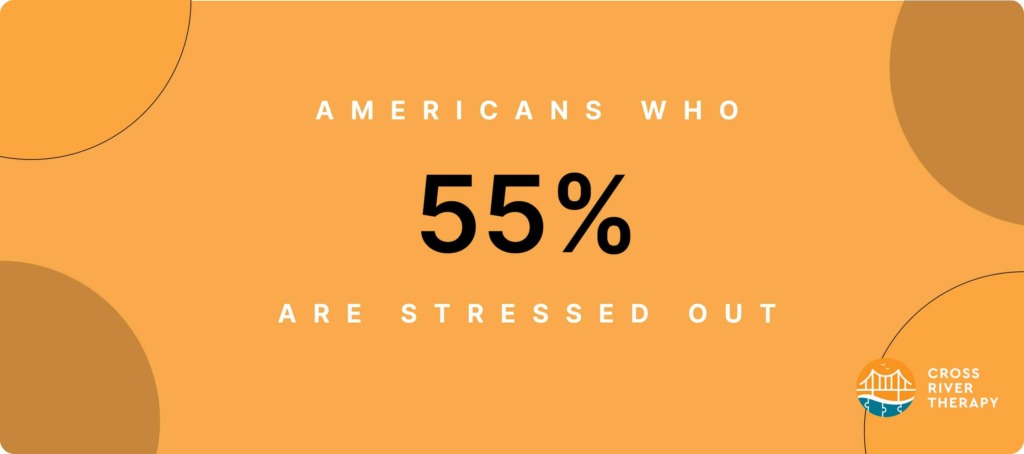
- 55% of Americans are stressed throughout the day.
- The number of stressed people out of 143 countries globally is 35% – which is 20% lower than the percentage of Americans who have stress.
- Approximately 33% of people report feeling extreme stress.
- 75% of Americans have experienced moderate to high levels of stress in the last month.
- The Global Organization For Stress reports that stress is the number one health concern of students in high school.

Americans are more commonly worried about the long-term well-being of the country.
In fact, 77% of American adults report that the future of our nation is a large source of their stress, up from 2019 when 66% of adults in the U.S. reported the same.
Also, 71% of Americans report this is the lowest point in our nation’s history that they remember. And in 2019, just 56% of Americans believed this.
The coronavirus pandemic is a significant source of stress in their life, as 78% of adults report the pandemic playing a big role in their day-to-day stress.
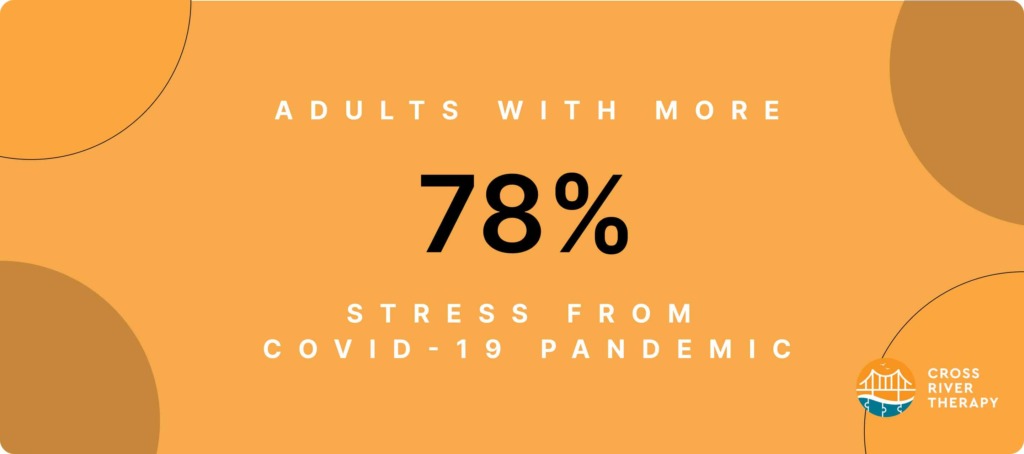
Stress is also impacting people’s physical and mental health, with 49% of adults reporting their behavior being negatively affected by stress.
Specifically, 21% of respondents say they’ve seen increased tension in their bodies, 20% report “snapping” or getting angry quickly, 20% report unexpected mood swings, and 17% report yelling or screaming at a loved one.
Workplace Stress Statistics
Workplace stress is one of the biggest challenges you can experience at work. It comes in all types of shapes and sizes, across all types of careers, industries, around the world.
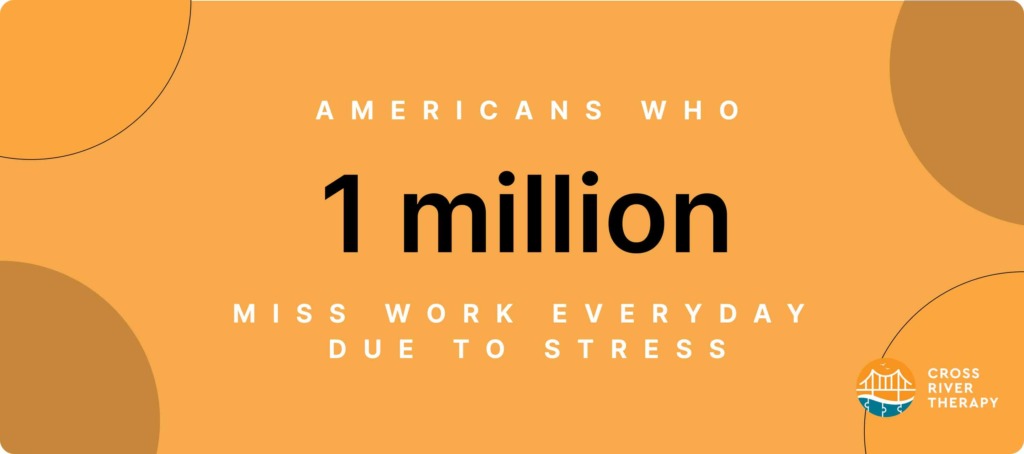
After considerable research and analyzation of the newest workplace stress statistics, here are the most up-to-date stats we’ve found:
- 63% of U.S. workers report they’re ready to quit their job to avoid work-related stress.
- Around 1 million Americans miss work each day because of stress.
- 76% of workers in the U.S. report that stress from work affects their personal relationships negatively.
- 31% of men and women handle stress from work by consuming more caffeine, 27% smoke, and 25% exercise more frequently than when they don’t have as much stress.
- U.S. businesses suffer $51 billion of depression-induced absenteeism costs every year, on top of an additional $26 billion in treatment costs.
- The main causes of workplace stress are workload (39% of workers), interpersonal issues (31%), juggling work and personal life (19%), as well as job security (6%)
- 94% of workers report feeling stress at work.
- 40% of workers report their previous job was very stressful.
- 25% of workers believe their jobs is their #1 stressor.
- 25% of workers report feeling like screaming or yelling because of their job stress.
- 10% of workers are worried about an individual at work they think might become violent.
- 9% of workers are aware of a violent act or an assault at work and 18% report having experienced someone at work intimidating or threatening them verbally in the last 1 year.
- 62% of workers end the day with work-related neck pain.
- More than 50% of respondents report they frequently spend 12-hour days on work related projects and an equal number report frequently skipping lunch due to the stress of job demands.
- 2% of respondents report having actually struck someone at work.
- 34% report having trouble sleeping due to work-related stress.
- 44% report stressed-out eyes.
- 12% report feeling pain in their hands.
- 12% report calling in sick due to their stress from work.

Top Causes Of Workplace Stress

- 4 out of 5 workers (80%) report that a change in leadership affects their stress levels.
- More than 1 in 3 workers (39%) report that workload is their main cause of stress.
- 4 out of every 5 of U.S. workers (80%) are stressed due to ineffective communication at work.
- Almost 2 out of every 3 employees (65%) say it’s difficult to concentrate because of their work environment. In 2018, less than 1 in 2 employees (46%) said the same.
Read More: Time Wasted In Meetings
Health Effects Of Stress At The Job

Stress At Work Statistics By Job Title & Industry
There are differences in stress-levels by job and industry. For example, healthcare professionals are often are more stressed than those working as a waiter/waitress. We’ve compiled some of the most and least stressful job titles in a variety of industries to help you better understand which career path you might choose.
Most Stressful Jobs
Least Stressful Jobs
Most Stressful Industries For Workers
Workplace Stress Statistics By Age & Gender

Workplace stress can drastically vary based on a worker’s age, race, and gender. And although there has been lots of progress made in many different industries and businesses, there is still lots more to be done.

Here are some statistics that show just how much workplace stress can vary by the individual’s age, gender, and race:
- In a survey conducted by APA Stress In America in 2016, women described their stress levels as 5.1/10, on a scale of one to ten. And men reported 4.4/10.
- More than 1 out of 2 working women (62%) in the U.S. as well as Canada reported feeling stressed on a daily basis compared to just over 1 out of 2 working men (52%).
- 50% of all LGBTQ+ employees stay closeted at work.
- Almost 43% of gay individuals and 90% of transgender individuals have experienced mistreatment or even harassment at work.
- Americans who are between 30 and 49 years old have the most stress. In fact, around 2 out of 3 individuals in that age group report high workplace stress. The 15-29 age group is right behind them, with 64%, and 44% of people older than 50 reported feeling stressed at work. As you see from these statistics, age plays a big role in how much stress someone has from their job.

Global Impact Of Stress
Stress causes people to stay home from work, go to the doctor, miss school, or even pass away. Unfortunately, it’s estimated that American employers spend $300 billion annually on health care as well as lost work days related to stress.

Also, up to 80% of workplace accidents come from stress or stress-related problems. For example, a construction worker is too tried or distracted to notice that there’s a sharp object on the floor which he/she accidentally steps on.
Stress isn’t only a costly issue in America, in fact, people in the UK miss 13.7 million work days because of stress every year. Australia has an extra $14.2 billion of costs and the UK around $37 billion in lost productivity every year.
Prevalence Of Stress Disorders
Acute stress disorder and post-traumatic stress disorder (PTSD) are common stress disorders which are triggered by trauma. Did you know that approximately 5% of Americans – more than 13 million people – have PTSD at any given time? Acute stress disorder also affects as many as 50% of all people who are exposed to a serious stressor that could even be life-threatening.
Read More: PTSD Statistics
Student Stress Statistics
With a finite number of hours per day to complete their classes, homework, chores, and other responsibilities, it’s not a surprise that students are experiencing stress throughout their childhood and young adult life.

We’ve compiled more than a handful of student stress stats that will help you be informed of the stress high school and college students face while trying to achieve their educational goals. Whether it’s college admission, an abundance of homework, exams, too many extra-curricular activities, or chores, students are constantly facing stress.
High School Students Stress
High school students have many academic, social, family, and peer responsibilities and pressure, from getting admitted to the college of their choice or exposure to other students bullying them, or even violence. Even more pressure comes from the COVID-19 virus that has changed the way many schools are operated.

This section will answer the common question: what percent of high schoolers are stressed?
The statistics below will help illustrate how much stress high school students have:
- 61% of teenagers ages 13-17 report they are under a lot of pressure to produce good grades. (Pew Research Center, 2019)
- 59% of teenagers plan on attending a 4-year college course after completing high school. (Pew Research Center, 2019)
- The passing rate for college applicants is around two-thirds (65.4%), and many high school students are constantly stressed about whether they’ll get accepted into the college of their choice.
- 3 out of 4 high schoolers and 1 out of 2 middle schoolers describe themselves as “always or often feeling stressed” by their homework. (The Washington Post, 2019)
- Almost 1 in 2 high school students (45%) report feeling stressed out all the time. (Global NewsWire)
College Students Stress
The previous section showed the main causes of stress in high school students, and what percentage of them are stressed on a regular basis. In this section, we’ll reveal the most common factors that influence a college student’s stress to give you some insights on the amount of pressure and stress college students face regularly.

This section will give an answer to the question: what percent of college students are stressed?
- Approximately 1 in every 2 college students suffer from stress. (WhatToBecome, 2021)
- More than 2 out of 3 college students report living away from their homes which they say is a source of stress. (WhatToBecome, 2021)
- On average, almost 1 in 2 college students in the U.S. feel well-rested for only two days a week. (WhatToBecome, 2021)
- More than 1 out of 2 college students report feeling “moderately”, “very”, or “extremely” worried about their mental health. (Inside Higher Ed, 2020)
- 3 out of 4 students in four-year colleges report having experienced a feeling of “overwhelming anxiety” during the last two weeks. (ACHA, 2019)
- Approximately 50% of college students have reported their academics causing them “trauma” or being “difficult to handle”. (ACHA, 2019)
Gun Violence and School Shooting Stress
Unfortunately, the U.S. remains a country where gun-related violence happens regularly, even in schools. The increasing reports of mass shootings have caused millions of students across the U.S. to have more stress related to their safety at school.
In fact, the threat of a school shooting or school violence can cause students to think about not attending classes in-person, or simply leaving school and going home.
The student stress statistics below will help you understand more about the concerns students face regularly:
- There are 3 million schoolchildren who get exposed to gun violence yearly. (Everytown, 2021)
- Black high school students in the U.S. are twice as likely to miss school due to safety issues, compared to white students. (Everytown, 2021)
- There was a total of 45 reported school shootings in just 46 weeks in 2019, which means there was an average of almost one school shooting per school week.

Top 10 Causes Of Stress
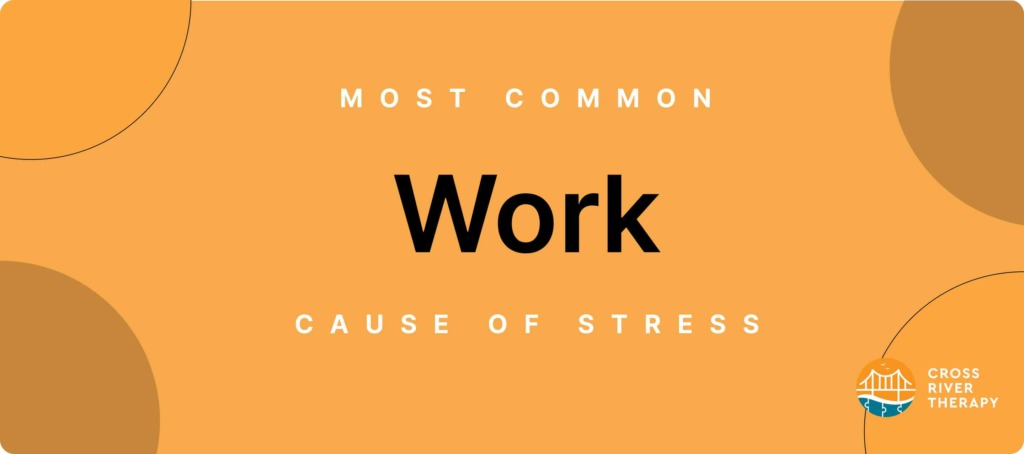
Almost anything can cause stress, but the causes depend on someone’s thinking patterns, coping skills, life circumstances, age, gender, and other factors. With that said, here are some of the most frequently cited sources of stress:
- Work
- Money
- The economy
- Family responsibilities
- Housing costs
- Job stability
- Family health problems
- Safety
- Relationships
- Personal health problems
Most Common Symptoms Of Stress

Various symptoms emerge once a source triggers an individual’s stress. However, using effective coping skills to manage stress is a solution that works for many stressed-out individuals. Here are the most common reported symptoms of stress, as well as the percentage of people who have them:
- Anger and irritability: 45%
- Low energy: 41%
- Lack of motivation or interest in things: 38%
- Worry or anxiety: 36%
- Headaches: 36%
- Feeling depressed or sad: 34%
- Acid reflux, upset stomach, or indigestion: 26%
- Muscle tension: 23%
- Appetite changes: 21%
- Sexual problems
- Weight changes
- Constipation or diarrhea
- Lack of attention
Cost Of Stress On The World
Stress, anxiety, and depression cost the global economy around $1 trillion in lost productivity, and approximately 1 million workers don’t show up to work every day due to the stress they’ve experienced at work.
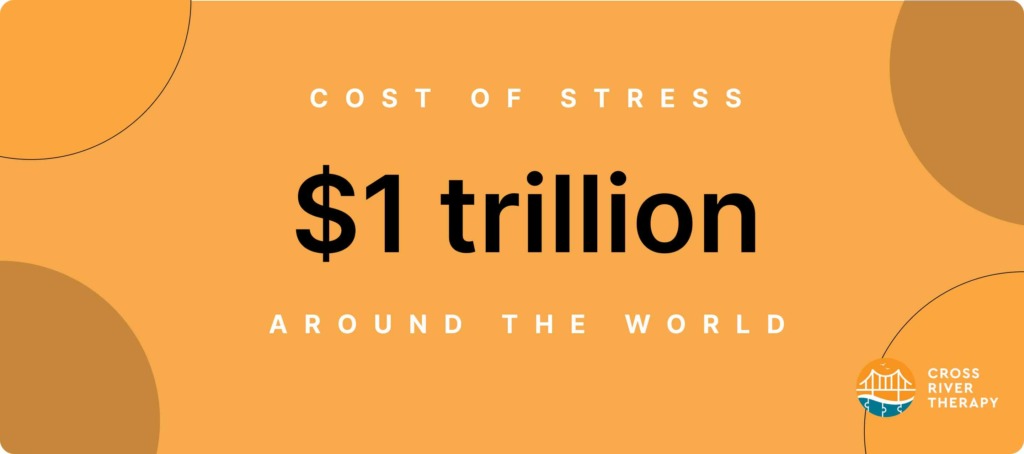
Frequently Asked Questions
What is stress?
Stress is a reaction the body has when changes in someone’s life occur. The result is either a physical, emotional, or intellectual response that everyone experiences. You’ll be surprised when you learn that the human body is actually designed to experience and react to stress.
Stress responses help us adjust to new situations, and they can be positive by keeping us motivated, alert, and ready to avoid danger. But stress can also become a problem when stressors continue without periods of relaxation and rest or relief.
How many people are stressed?
Here’s a stressful fact: 55% of Americans are stressed during the day, and approximately 1 in 3 people report feeling extreme amounts of stress regularly.
What age is stress most common?
According to the American Psychological Association (APA), people in the 18-33 age group suffer the highest levels of stress in the U.S.
How many deaths are caused by stress every year?
Tragically, the American Institute of Stress reports 120,000 people die every year, directly as a result of work-related stress. And healthcare costs total to around $190 billion a year resulting from work-related stress.
What percentage of diseases is caused by stress?
Medical research estimates that up to 90% of illness and disease is related to stress. It’s known that stress can interfere with your physical well-being and bodily processes, and if you have unhealthy levels of stress and you don’t find ways to manage it, you could experience:
- High-blood pressure
- Cardiovascular disease
- Heart disease
- And more
In short, find ways to manage your stress, and if possible, find ways to eliminate stress from your life so you can keep yourself as healthy as possible.
Stress Research

Have Any Questions?
Whether you're curious about our services or need support, we're just a click away. Reach out or check our FAQs for quick answers.

